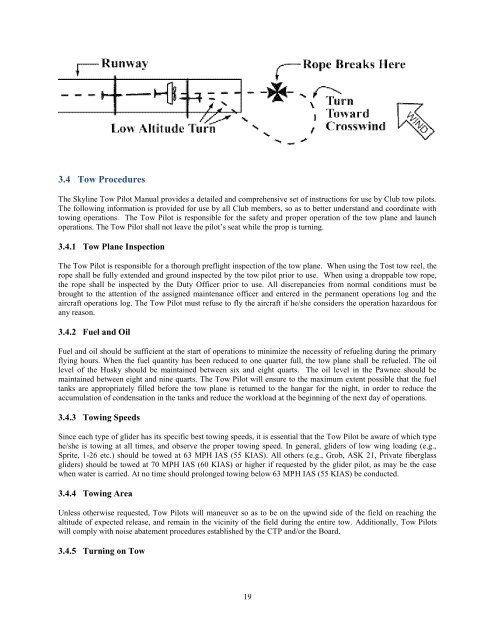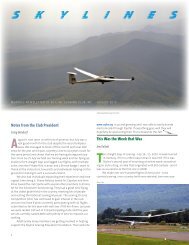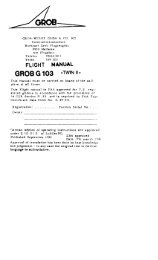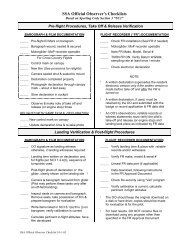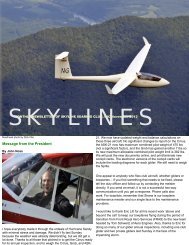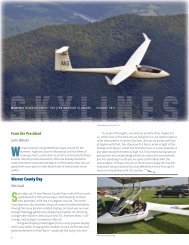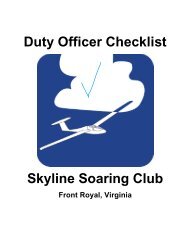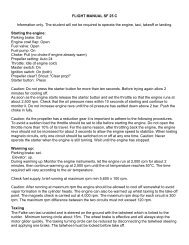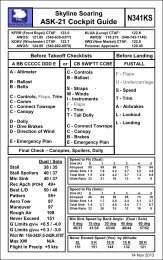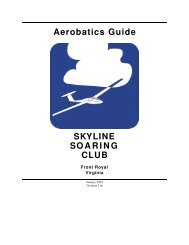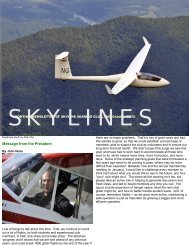Skyline Soaring Club Operations Manual
Skyline Soaring Club Operations Manual
Skyline Soaring Club Operations Manual
You also want an ePaper? Increase the reach of your titles
YUMPU automatically turns print PDFs into web optimized ePapers that Google loves.
3.4 Tow ProceduresThe <strong>Skyline</strong> Tow Pilot <strong>Manual</strong> provides a detailed and comprehensive set of instructions for use by <strong>Club</strong> tow pilots.The following information is provided for use by all <strong>Club</strong> members, so as to better understand and coordinate withtowing operations. The Tow Pilot is responsible for the safety and proper operation of the tow plane and launchoperations. The Tow Pilot shall not leave the pilot’s seat while the prop is turning.3.4.1 Tow Plane InspectionThe Tow Pilot is responsible for a thorough preflight inspection of the tow plane. When using the Tost tow reel, therope shall be fully extended and ground inspected by the tow pilot prior to use. When using a droppable tow rope,the rope shall be inspected by the Duty Officer prior to use. All discrepancies from normal conditions must bebrought to the attention of the assigned maintenance officer and entered in the permanent operations log and theaircraft operations log. The Tow Pilot must refuse to fly the aircraft if he/she considers the operation hazardous forany reason.3.4.2 Fuel and OilFuel and oil should be sufficient at the start of operations to minimize the necessity of refueling during the primaryflying hours. When the fuel quantity has been reduced to one quarter full, the tow plane shall be refueled. The oillevel of the Husky should be maintained between six and eight quarts. The oil level in the Pawnee should bemaintained between eight and nine quarts. The Tow Pilot will ensure to the maximum extent possible that the fueltanks are appropriately filled before the tow plane is returned to the hangar for the night, in order to reduce theaccumulation of condensation in the tanks and reduce the workload at the beginning of the next day of operations.3.4.3 Towing SpeedsSince each type of glider has its specific best towing speeds, it is essential that the Tow Pilot be aware of which typehe/she is towing at all times, and observe the proper towing speed. In general, gliders of low wing loading (e.g.,Sprite, 1-26 etc.) should be towed at 63 MPH IAS (55 KIAS). All others (e.g., Grob, ASK 21, Private fiberglassgliders) should be towed at 70 MPH IAS (60 KIAS) or higher if requested by the glider pilot, as may be the casewhen water is carried. At no time should prolonged towing below 63 MPH IAS (55 KIAS) be conducted.3.4.4 Towing AreaUnless otherwise requested, Tow Pilots will maneuver so as to be on the upwind side of the field on reaching thealtitude of expected release, and remain in the vicinity of the field during the entire tow. Additionally, Tow Pilotswill comply with noise abatement procedures established by the CTP and/or the Board.3.4.5 Turning on Tow19


